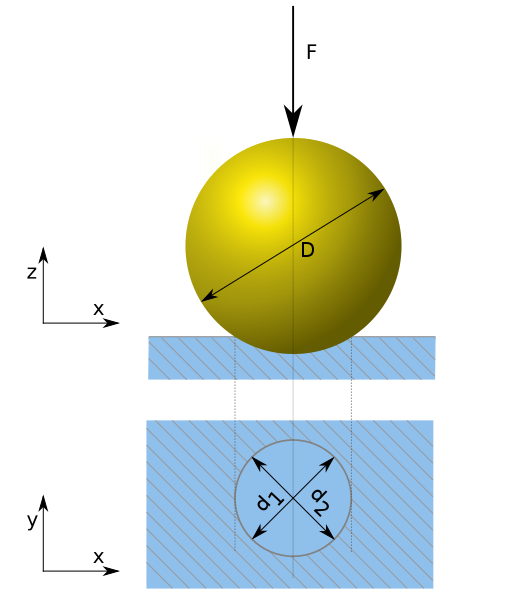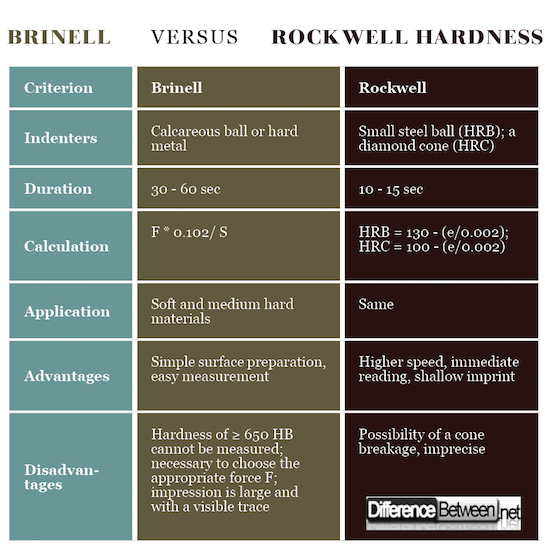Difference Between Brinell and Rockwell Hardness
Hardness testing is one of the most widely used material testing methods. Static hardness measurements are convenient for accurately determining the hardness.

What is Brinell Hardness?
Brinell hardness (HBW) is the ratio between the applied force and the surface of the print. Indenter is a hard metal ball, with a diameter D that is imprinted by force F into the surface layers of the material. The diameter of the ball is standardized and amounts to: 10; 5; 2.5; 1mm.
By imprinting the test material, a print of the shape of the cubic diameter of the base diameter dB and the depth hB is generated. The Brinell hardness meter uses an impulse force of 9.807N to 29420N depending on the test material and the diameter of the impeller ball.
The load is usually applied for 10 to 15 seconds in the case of testing steel or steel materials, and for other softer materials the load must be applied at least 30 seconds. The subject to be tested must be purified and defatted, and the surface smooth so as the measurement to be as precise as possible in order to determine the diameter of the bowl of the calotte.
During the measurement, there must be no vibration, because they could unduly influence the values of the measured hardness. Brinell’s hardness is a dimensionless size. In comparison with other hardness testing methods, Brinell’s ball leaves the deepest and largest print, and thus functionally and/or aesthetically disfigures the surface (if the hardness is measured on the product rather than on the sample).

What is Rockwell Hardness?
Unlike Brinell’s and Vickers’s methods, Rockwell’s method does not measured the size of the imprint, but the depth of penetration of the indenter. That is why in case of Rockwell the hardness is read on the hardness scale, after it has been released.
Inductors are made of a diamond stem or ball of acacia. The stem diamonds have a peak angle of 1200 and a radius of 0.2mm round, while the ball diameter is 1/16″ and 1/8″. HRB (ball) test is used for soft and medium hard metals while HRC (cone) is used for hardwoods and typically heat-treated materials.
The total possible penetration depth of the indenters is 0.2mm (HRC) or 0.26mm (HRB) and is divided into 100 parts by HRC method or 130 for the HRB method, so hardness at Rockwell’s method is: 1e=0.002m. In the HRC method the indenter has a form of a diamond trunk, which is loaded with pre-load F0=98.07 N for a period of 3 seconds, thus obtaining a starting point from which the penetration depth is measured.
The total load F follows, by adding the main load F1=1373N, for a duration of 4±2 seconds, and the amount of hardness defines the depth of penetration of indenter hR, after removal of main load F1, when backfilling occurs due to material elasticity. For the HRB method, the principle of measurement is the same, except that the steel ball is imprinted with a preload of F0=98.07N or main load F1=882.6N so that the total load is F=980.7N.
Difference Between Brinell and Rockwell Hardness
-
Indenters of Brinell and Rockwell Hardness
In case of Brignell’s method, the penetrator is a calcareous ball (for hardness up to 450HB) or hard metal (for hardness up to 650HB) of diameter D, which is emitted by force F in the surface layers of the material. The standard diameters of balls are 10, 5, 2.5, 2 and 1 mm.
In Rockwell’s method several types of penetrators are used: for soft materials, a small steel ball (HRB method) is used, for hard materials a diamond cone (HRC method). The diamond cone has a peak angle of 1200 and a radius of 0.2 mm round, while the diameter of the steel balls is 1/16″, 1/8″, 1/4″ and 1/2″.
-
Duration of Brinell and Rockwell Hardness
The Brinell test is very slow (30 – 60sec).
Rockwell’s test is shorter (10 – 15sec).
-
Calculation of Brinell and Rockwell Hardness
Brinell’s Hardness (HB) is the ratio of the applied force F (N) and the surface of the fingerprint S (mm2): HBW = (F*0.102/ S); S = π* D* h.
In Rockwell’s method HRB = 130 – (e/0.002); HRC = 100 – (e/0.002)
-
Application of Brinell and Rockwell Hardness
The Brinell method is used for soft and medium hard materials.
Rockwell’s test is used for soft and medium hard materials (aluminum, soft steel, Cu alloys etc.)
-
Advantages of Brinell and Rockwell Hardness
Advantages of Brinell’s method is the simple surface preparation and the easy measurement of the print diameter.
Rockwell method is faster, there is higher speed immediate reading of hardness on the device and the test leaves shallow imprint.
-
Disadvantages of Brinell and Rockwell Hardness
Disadvantages of Brinell’s method are that hardness of ≥ 650 HB cannot be measured; the hardness is dependent on the load and according to X (degree of load) so it is necessary to choose the appropriate force F; after the measurement, the impression is large and leaves a visible trace.
For Rockwell’s test there is the possibility of a cone breakage and the imprecision ± 2 HRB / HRC.
Brinell vs. Rockwell Hardness: Comparison table

Summary of Brinell Verses Rockwell Hardness
- The Brinell and Rockwell methods fall into the group of statistical methods of hardness testing. Each method has its unique purpose, advantages and disadvantages.
- Difference Between Thermodynamics and Kinetics - June 24, 2018
- Difference Between Welding and Soldering - June 24, 2018
- Difference Between Additive Colors and Subtractive Colors - June 20, 2018
Search DifferenceBetween.net :
1 Comment
Leave a Response
References :
[0]Callister, W. D., &. Rethwisch. D. G, Fundamentals of Materials Science and Engineering. NJ: John Wiley & Sons, 2008.
[1]Tabor, D. The Hardness of Metals, Oxford: Oxford University Press, 2007
[2]Dowling, N. Mechanical Behavior of Materials, NJ: Prentice Hall, 1993.
[3]Image credit: https://upload.wikimedia.org/wikipedia/commons/thumb/d/de/BrinellHardness.svg/520px-BrinellHardness.svg.png
[4]Image credit: https://en.wikipedia.org/wiki/File:Hardness_comparisons_(Brinell_hardness).png#/media/File:Hardness_comparisons_(Brinell_hardness).png

Valuable info, do working like this.
Thanks.